Listen to the podcast episode
Transcript, photos, and show notes
My wife and I recently had the privilege to eat at Indienne Chicago, a Michelin Star restaurant. I’m not normally one to gawk over awards and accolades, perhaps a consequence of my parents comments on the B+ from my report cards. Awards for food seem a bit silly to me because everyone has their own tastes and preferences and most of the food from award winning restaurants I tried in the past did not appeal to me.
But after a year of publishing YouTube videos and podcast episodes about Indian food in North America, I was curious to see what critically acclaimed Indian food is. I was also curious to see if it would just be a fancy recreation of the stereotypical Indian lunch buffets of our childhoods, just in smaller portions.
Every millennial and Gen-X ABCD remembers what Indian food was in the 80s and 90s. Indian restaurants were usually serving all-you-can-eat lunch buffets in suburban strip malls. Our parents may have been chummy with the owners, a result of the small Indian American communities in the town. The dishes were the usual greasy, oily, heavy, and spicy food now synonymous with Indian food to the typical American: butter chicken, chicken tikka masala, and oily garlic naan. That was how our classmates and neighbors saw Indian food. All delicious, but not representative of the food we are at home: ghar ka khaana घर का खाना. The flavors were similar to what we ate at home, but it wasn’t the same. The Indian restaurant food of the 90s was somehow…different.
I don’t say this to disparage these restaurants. I have many fond memories of eating garlic naan and chicken tikka masala there. Much like how our parents moved from India and needed to assimilate to western standards in order to make a living, the dishes at these early South Asian restaurants also needed to assimilate to western tastes to survive. These restaurants were good ways for many Aunties and Uncles to make a living in North America and give their children a chance for a better life. There weren’t enough Indians in town to keep the businesses afloat making food for Indian taste buds. Americans wanted Indian food to be spicy and glutenous, and these Aunties and Uncles met the demand to keep the businesses running.
But it didn’t represent the Indian food we ate at home or the food we ate when visiting our grandparents in India: ghar ka khaana घर का खाना. Where was the khichdi? Or the dal? Or the rotis?
These stereotypical dishes originated from British origins. Butter chicken was invented to feed British colonial troops serving in the Peshawar region of modern day Pakistan by taking the available ingredients in South Asia and applying it to British taste. Food writer and historian Pushpesh Pant says of butter chicken: [quote] “It is essentially a non-Indian dish. Satin-smooth, butter-laden gravy, boneless chicken. This is the lowest common denominator for a non-Indian palate.” [end quote]
Lizzie Collingham, the author of Curry: A Tale of Cooks and Conquerors says chicken tikka masala has a similar origin: [quote] “It’s exactly the same story, and it’s invented for picky British people who don’t want to eat dry chicken.” [end quote] Legend has it that one night in the ’70s, a Pakistani-Scottish man, Ali Ahmed Aslam, made a sauce out of a can of tomato soup and cream and poured it over a tandoori chicken after a customer in his Glasgow restaurant complained it was too dry.
Recently in 2016, acclaimed British-Indian Chef Atul Kochhar even opened a restaurant in Mumbai called NRI with a menu of dishes typically associated with Indian cuisine in the West. The name is a play on the common term Non-Resident Indian which describes Indian citizens living abroad, like many of our parents were when they first left India. Although the abbreviation is sometimes derogatorily changed to stand for Not Really Indian. The restaurant is a taste for Indians in India to understand how the West sees Indian food.
Around the year 2000, I remember a Mysore Woodlands South Indian restaurant opening up near a local South Asian grocery store. It served dosa, idli, vada, sambar, and chutney. My Tamil parents were very excited to finally eat their food at a restaurant. Looking back, I can see my parents’ pride that Indian food was expanding from the stereotypical British-Indian dishes to food Americans may not have tried before. Of course, now Saravana Bhavan operates several restaurants around the country happily serving Indian-American immigrants, their children, and anyone else interested in South Indian food.
While still relatively rare, it’s now possible to find Marathi, Bengali, and other South Asian cuisine restaurants. A sure sign of progress for our culture in North America. For example, the Malayali restaurant Thattu in my own Chicago is getting recognition as a hot new restaurant.
There was even a video game released in 2023 called Venba which heavily features Indian food. The premise of the game is for a homesick immigrant mother in Canada named Venba to recreate her family’s recipes: ghar ka khaana घर का खाना. Would any of us ABCDs have imagined a video game about Indian food when we were kids? We had a better chance to get into Harvard Medical School, as our parents reminded us often.
As the years have gone on, we have seen Indian food expand even further.
Previously mentioned, Atul Kochhar was the first Indian Chef to be awarded a Michelin Star for his restaurant Tamarind in the UK in 2001. Indian fine dining in the US gained recognition in 2004 when the New York restaurant Devi was awarded a Michelin Star.
Today, the company Unapologetic Foods in New York runs three restaurants which all feature Unapologetically Indian food. I love that name.
Their restaurant Dhamaka’s tagline is “The other side of India, the forgotten side.” Their menu features dishes such as Kashmiri Gosht Chaamp and Marathi Kolambi ani Kekda Bhaath.
One of their other restaurants, Semma, was awarded a Michelin Star in 2022 serving unapologetically South Indian food in a traditional manner. When I heard the news, I was surprised that French trained culinary critics would give dosa and sambar the same accolades as foie gras and steak.
Michelin, yes the same Michelin as the tire company with the puffy mascot, currently lists 137 Indian restaurants in their worldwide guides with seventeen having at least one coveted Michelin Star. Of those seventeen restaurants, only three are in North America: Rania in Washington, DC, Semma in New York, and Indienne in Chicago. The majority are in the UK with the rest in Hong Kong, Dubai, and Thailand. Unfortunately, Michelin does not make travel guides for India so all of the wonderful restaurants in India cannot earn these awards.
With all of this progress from our community, what exactly is fine Indian cuisine? I wasn’t sure what to expect when I arrived at Indienne. Based on my previous experience at Michelin Star and James Beard Award winning restaurants, I expected small portions with fancy table settings. That was accurate with fancy ceramic dinnerware, dim lighting, and soft Hindi music playing in the background. But would the food be similar to the meals I had in India and at numerous aunties and uncles’ homes? Or would it be a fancy version of my childhood’s chicken tikka masalas made for Western palettes?
The menu and wait staff described the first course as pani puri. When it arrived and looked more like a fruit tart than bite size puri, I rolled my eyes. It looked like a mini blueberry cake sitting in a flower shaped pastry with edible flowers on top.
I posted pictures of the dishes on the Cook Like An Aunty website, but please pardon the photo quality. I wasn’t planning to make any Cook Like An Aunty content from this restaurant visit. See the link in the show notes for the web page.
No doubt this dish looked beautiful, but it looked nothing like the pani puris of India filled with potatoes, onion, yogurt, and tamarind chutney.
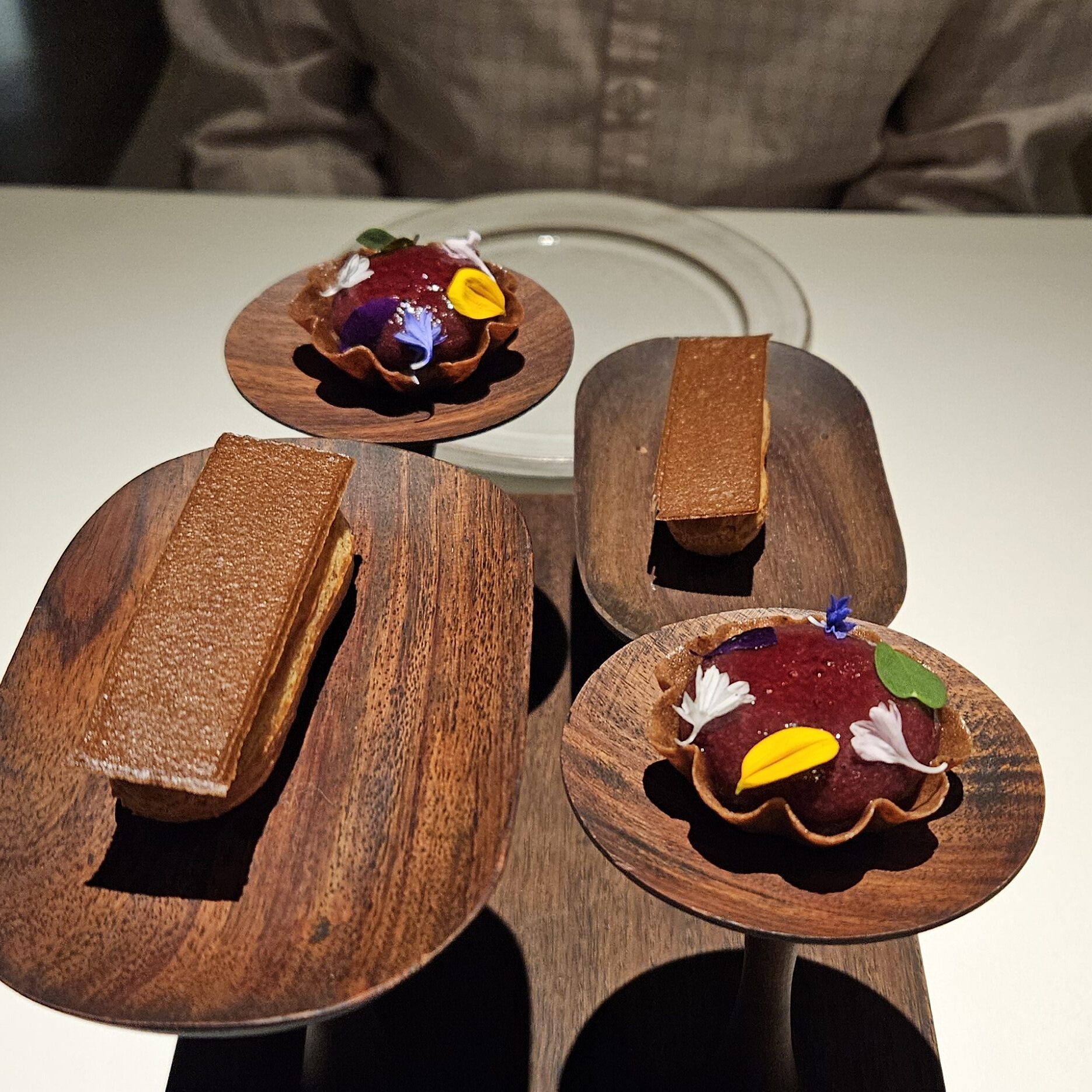
But then I tried it and my impression changed immediately: Ghar ka khaana घर का खाना
It tasted exactly like the pani puris from Indian restaurants or those made lovingly by an aunty when you go to her house for chaat. And more surprising, the texture of this fruit tart look-alike was spot on with eating a regular pani puri.
From then on, I was much more open minded. Despite the French cuisine inspired presentation, Indienne’s chef and staff managed to provide the true flavors and textures of Indian food.
Much like the pani puri experience, we had a dahi vada course. The menu described it as a lentil donut, which is fairly accurate in my opinion. It looked fancy again. It sat on a bed of vermicelli pasta but under what I can only describe as a dried yogurt shell. The yogurt shell had drops of mint and tamarind chutneys and what looked like pomegranate seeds. After placing the food in front of us, the waiter poured a yogurt, mint chutney mix around the vada. Once again it tasted exactly like its Indian namesake dish. My tastebuds instantly recognized the textures and flavors of dahi vada. Another A+ in my book.
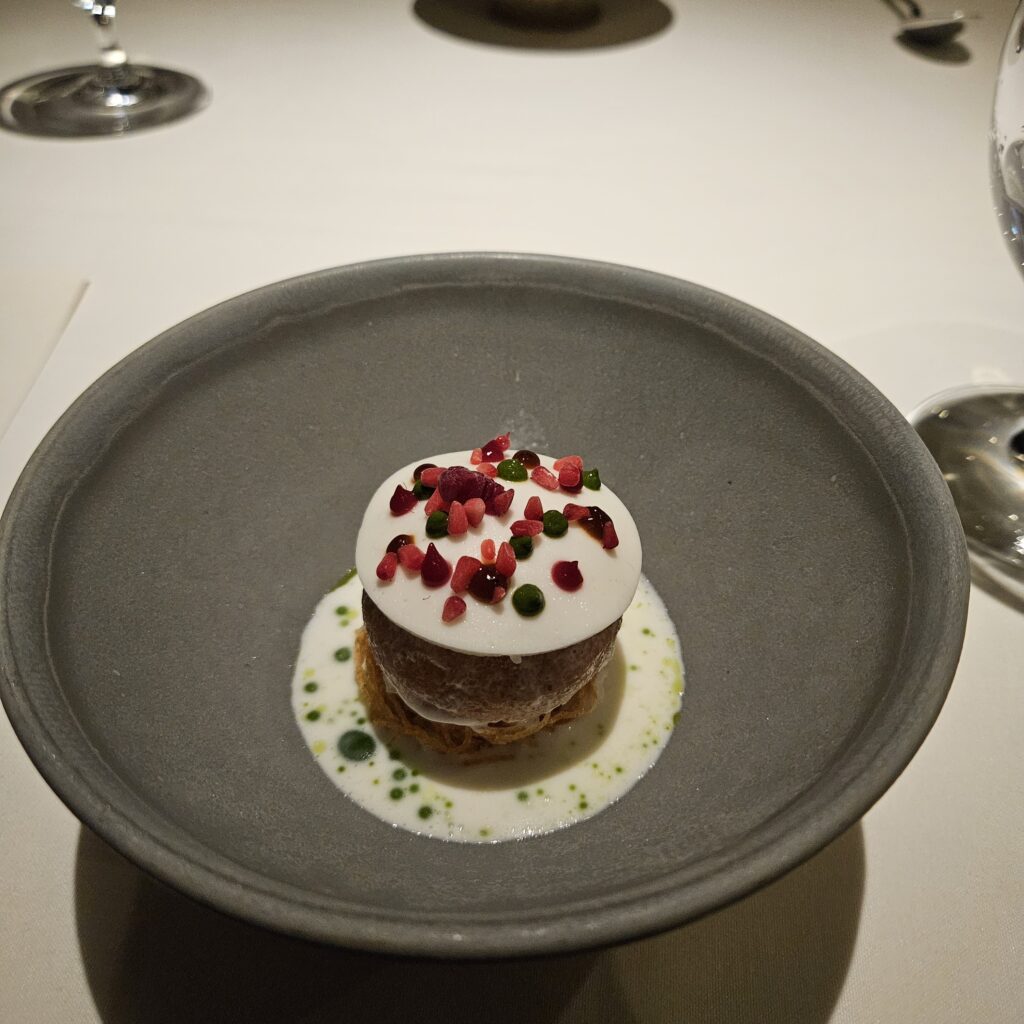
Perhaps partly because of the intricate platings and upscale decor, the flavors were not afraid to be authentically Indian.
My wife ordered from the vegetarian menu. She had a dish that was described as a Jackfruit Haleem served with a brioche bread. It was essentially a pav bhaji and it avoided the typical heavy oil and salt typically associated with the street food version. She said it was very good.
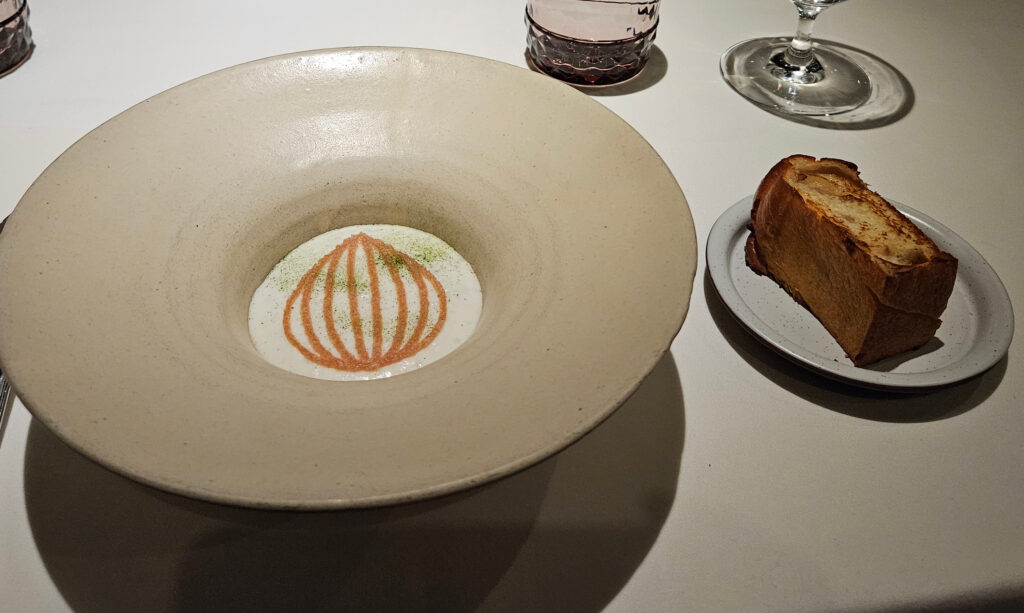
I also enjoyed that the staff encouraged us to eat with our hands when appropriate for the dish. Indian food vlogger Kripal Amanna often notes how eating with your hands creates a connection with the food that silverware cannot provide. Your first interaction is with sight and smell. Then you get to feel the food with your hands which increases the mind’s curiosity and understanding of the dish. Finally you get the taste. I’m glad that Indienne didn’t try to act too refined to encourage guests to eat with their hands.
From the non-veg menu, I ate a crab bisi bele bath. As I said in the Khichdi podcast episode, bisi bele bath is a cousin of khichdi from Karnataka which is a mix of lentils and rice. The restaurant described it as a risotto and it seemed like they used risotto instead of other rices traditional with bisi bele bath in Karnataka.The fusion was very enjoyable and I got the same comforting warmth from a homemade khichdi. Maybe I’ll start putting seafood in my homemade khichdi because this dish was delicious. I’m glad a khichdi-like-dish finally got its recognition as part of an Indian restaurant meal.
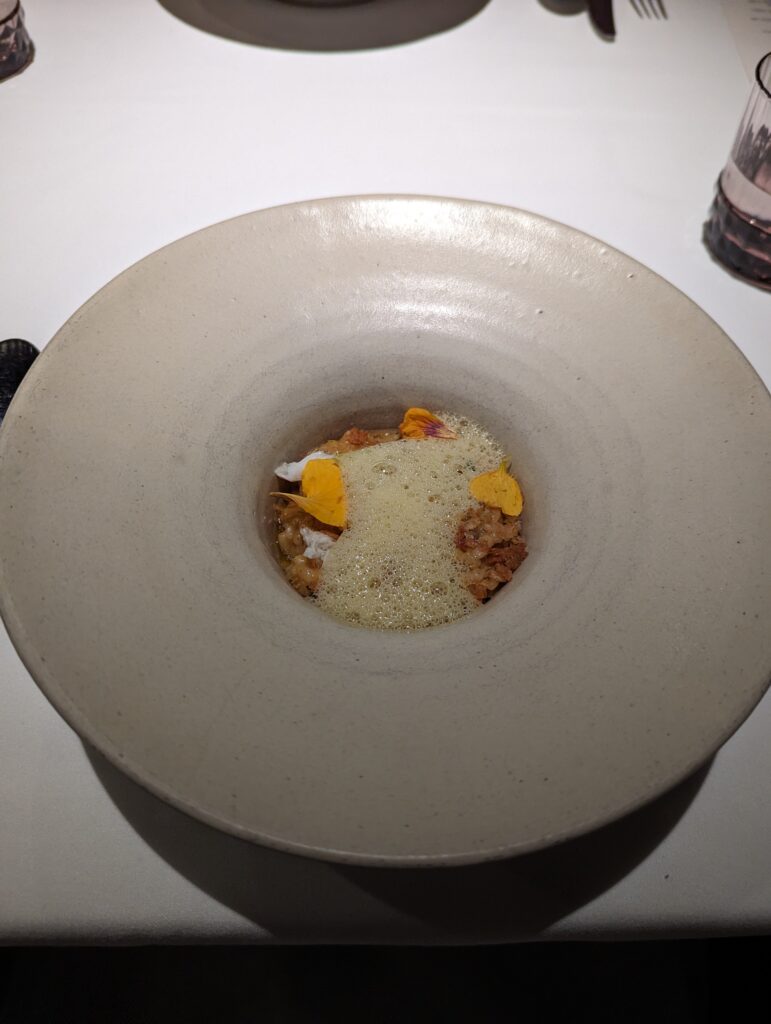
In my opinion, the best dish of the night was a Goan dish called Balchao with scallops. This isn’t a dish I have ever had before so I can’t comment on its flavor accuracy, but it had the characteristic sour and spicy flavors of Goan cuisine. It was seared scallops served on a slightly oily, spicy, and sour vinaigrette. It had a melt-in-your-mouth buttery texture. Absolutely delicious!
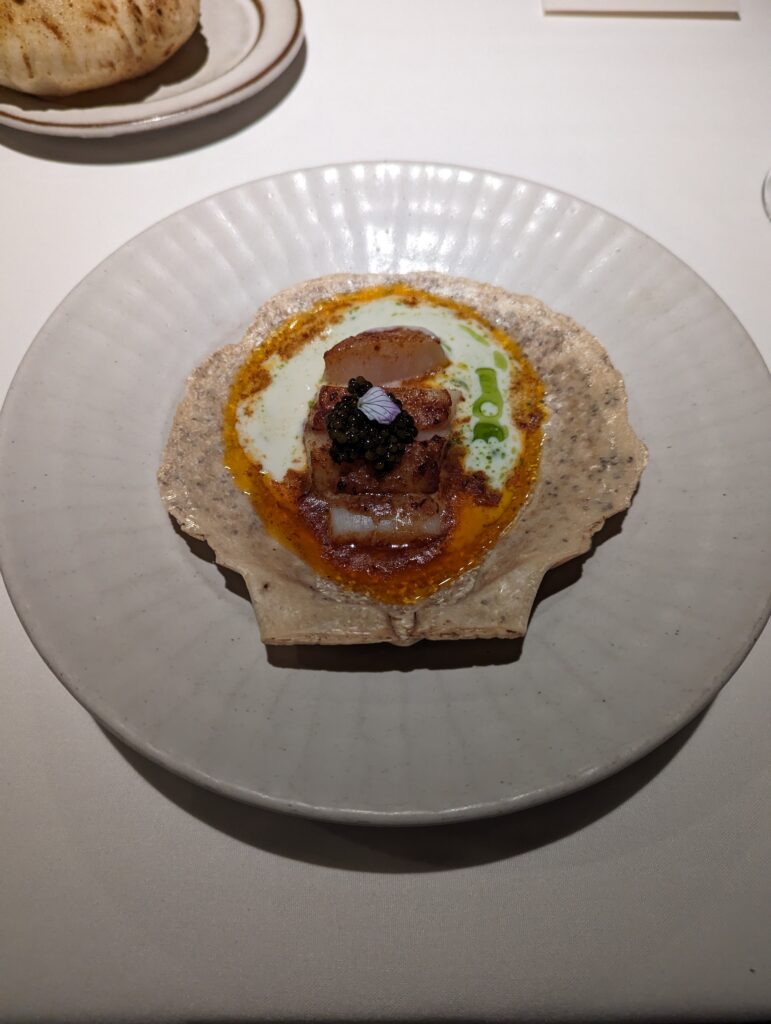
At this point, we noticed that Indienne was making the dishes slightly more spicy as we went on. No doubt, they put a lot of thought and effort into planning the menu so each dish builds on the previous one. Still, nothing was over the top spicy for this ABCD. It seemed to match the spiciness of food in restaurants in India.
Finally, I had what the menu listed as chicken makhani, which translates to butter chicken. I was disappointed that even a restaurant of this high acclaim which presented so many perfect dishes from across South Asia included this dish on their menu. I had to wonder, if Indienne didn’t have spicy chicken covered in creamy tomato sauce on the menu, would they have still won all their awards? Even one of the best restaurants in the world isn’t immune to including butter chicken. I think Indienne would have been just as deserving of the award either way. Because Michelin’s judges are anonymous, we don’t know which menu they tried. We will never know for sure.
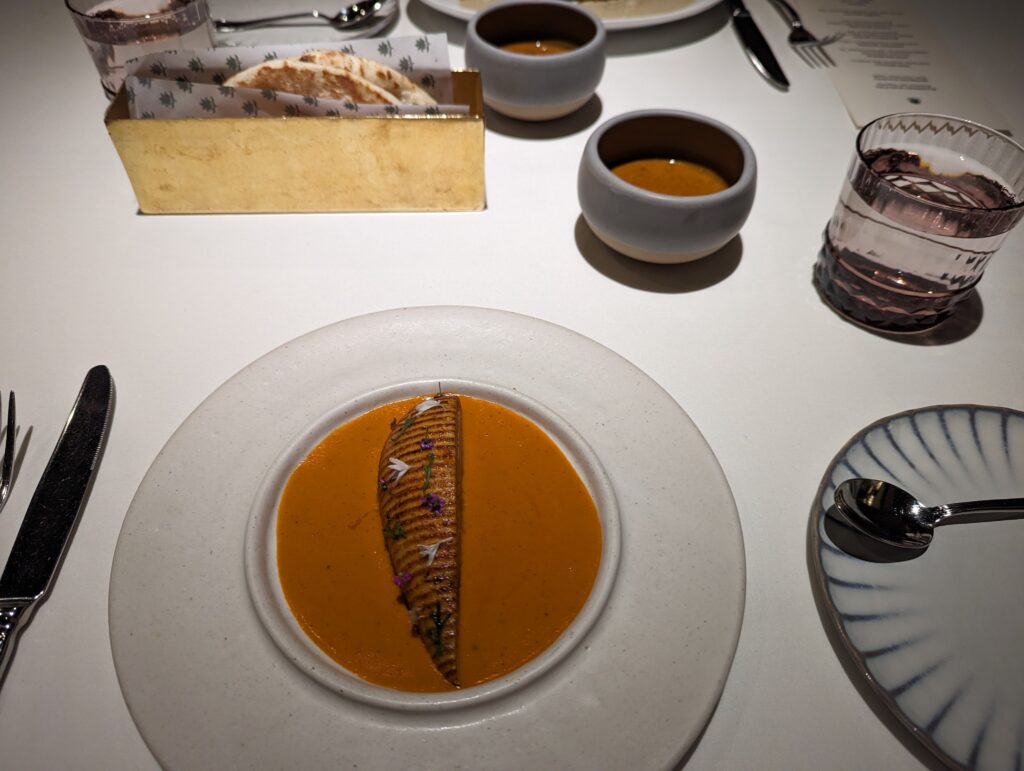
The chicken makhani was delicious, as all butter chicken dishes are. The restaurant served the chicken as a mousse and included a delicious, fluffy garlic naan. This course also included a dal makhani which was the spiciest item on the menu, but not overwhelmingly spicy. In my opinion, the dal makhani with naan would have been a better main course for the meal than including the chicken makhani.
In many ways, this meal reminded me of the second-generation Indian American experience in North America. It straddles the line between Indian and American. At the heart of the meal, the flavors were Indian, much like the underlying culture and values our parents used to raise us. But like the pani puri that looked like a Western pastry dessert, we are also very much America in our identities. The meal had the appearance of completely assimilated American food but had the taste and flavors that were authentically Indian.
Until recently, it felt like a small group of European cuisines held the prestige of elite dining. All other cuisines had to conform to French or Italian standards to be considered excellent.
But with restaurants like Indienne, Semma, and those representing other cuisines from around the world, the culinary world is taking note of the beauty from other cultures.
And this phenomenon is not only at fine dining establishments. The butter chickens of the 90s are getting replaced in suburban strip malls with Indian restaurants that are no longer afraid to be Indian. Restaurants like Devi and Saravana Bhavan paved the way, but now other restaurants are building on their work. Eggholic serves Indian street food in 20 locations across North America. Honest Indian has 44 locations outside of India with a diverse menu from several regions of India.
Now that Indian food is getting recognition, maybe aspiring South Asian entrepreneurs will create Indian restaurants of all varieties. Maybe one day we will see casual pani puri restaurants next to sushi restaurants. Or Mumbai sandwich shops for the downtown lunch rush. Perhaps our cuisine will be as popular, diverse, and authentic as others in America.
The most enjoyable part of visiting an award winning Indian restaurant was the pride I felt for my Indian heritage. Indian cuisine, and our Indian American community has made huge leaps from the stereotypical butter chicken of the 80s. Much like Indian food in the west, members of our South Asian community are breaking barriers with success in art, media, and many other fields that were impossible to dream thirty years ago. I hope my children will not have to answer the innocent but annoying questions from their classmates about if they eat curry at home and why Indian food is so spicy. And maybe we will go to a suburban Indian lunch buffet as a family and my children will beam with pride that the bisi bele bath and dal makhani are their food and their culture: ghar ka khaana घर का खाना.
Sources
Michelin Starred Indian Chefs (Lifestyle Asia)
List of Michelin Starred Restaurants in New York City

